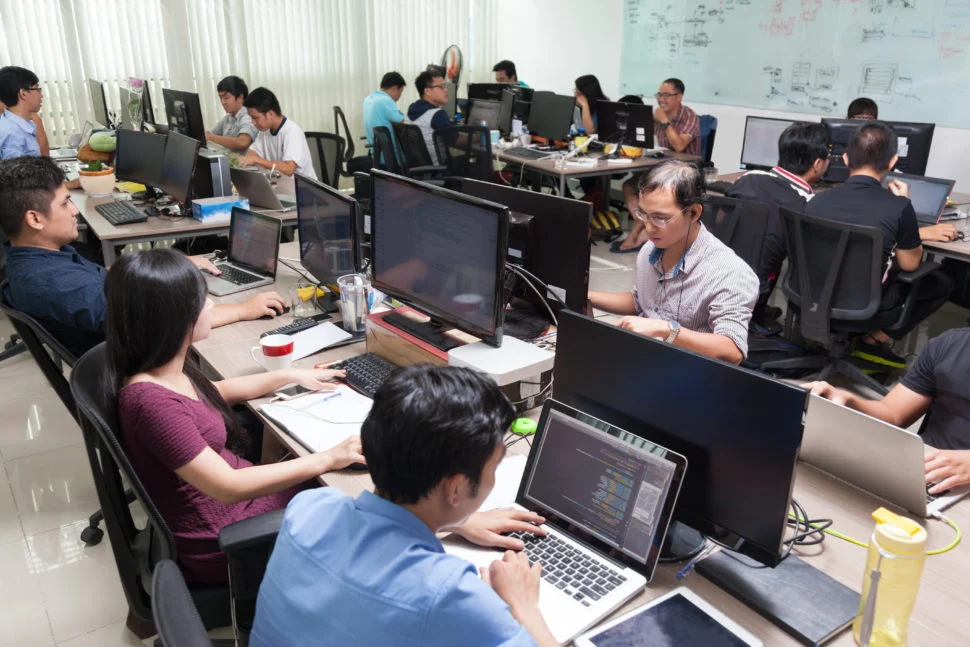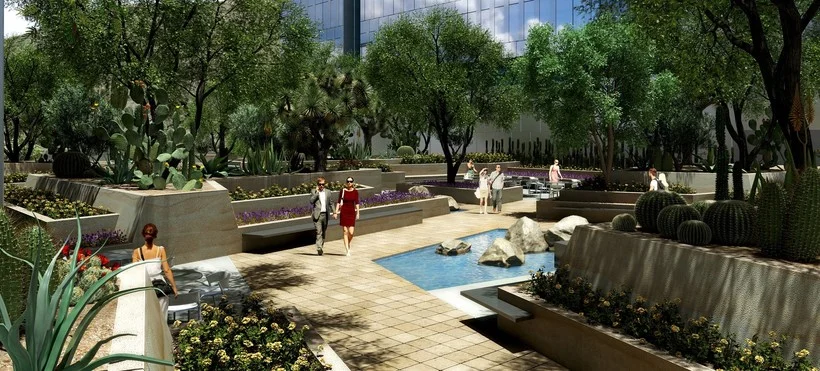About ten years ago, I shut down our offices. Everyone in my company works remotely from their home offices or at clients. The decision could not have been timed better. Besides saving on overhead, it seems that I avoided one of the worst office design trends ever embraced by corporate culture: the dreaded "open office."
The Evolution of the Office: Cubicles, Open Offices, & the Next Generation
Open office design may seem like a new concept that sprang to life in offices across America at the start of the 21st century, however it actually has its roots in the early 20th century where the open office was king until the 1960’s. These early office spaces were filled with large open floor plans with rows and rows of identical desks facing the boss’s office so he could keep an eye on everyone. These “white collar factories” were designed for efficiency and to fit as many people as possible with no regard for privacy and the individual’s needs.
Staying Connected at Work: 1900s to Now
Since the world’s first skyscraper went up in Chicago in 1885, people have converged to work together for a common goal. Companies and how people work together have changed dramatically since then and, in recent years, these changes have come fast and furious.
How the smart office revolution will transform the way we work
After years of speculation, 2017 appears to be the year when the Internet of Things becomes an ever-present part of our lives. The rise of smart speakers like the Amazon Echo or Google Home and wearables like the Fitbit means that smart objects are making our lives easier.
LISTEN: Episode 41 - Legal Design
IA Principal, Project Director, and Head of the Vertical Markets Group on Law Firm Design Erik Hodgetts highlights the current trends and challenges of legal design.
Report: Shrinking office space has big impact on city planning
Few industries ride the boom and bust of the American economy as closely as the commercial real estate sector, which can be both a bellwether of success or one of the first to be bludgeoned by a downfall. By nature, it’s a cyclical business. But according to research by REIS, analyzed by City Observatory, while many areas continue to build high-rises and new office space, the square footage per employee has shrunk dramatically during the recent economic upswing. And that smaller footprint has big implications for development and planning.
WHY THE LOBBY DESIGN SHOULD REFLECT THE BRAND
When you walk through the front door of a business, you get an instant sense of the company’s culture. The colors, lighting, signage, furniture, floor coverings and flow—they all say something about the who, what, why and how of the business. The lobby makes the first impression.
Workplace and Technology: The Integration Challenge
In today’s day and age, technology allows for more interconnectivity than ever. Wi-Fi is available nearly everywhere, whether we are sitting in a coffee shop or aboard an airplane. We can remotely monitor our homes camera systems, and change the thermostat while away. We can even have face-to-face chats with family members across the ocean with a touch of a button. So why, with all of the modern technology available today, do we still have so many technology issues in the corporate setting? Why does IT staff need to be involved almost every time you want to start a meeting and use video conferencing or online collaboration tools? Why do our corporate systems “go down” at the worst times? Why do we need to call IT to make sure the tech in the boardroom is working and set up before you enter the meeting?
Six Design Principles to Support Wellbeing
What do busy workers need most from their workplaces today? First and foremost, they need it to be human centered; a workplace crafted to mentally excite and engage, physically comfort and emotionally support the people that work there. Although many have predicted the death of the office since mobile technologies allow workers the ability to be productive on the go, people have discovered they need more. Needs for collaboration, team building and individual focus are just a few reasons employees are heavily relying on their office to provide them with access to the people and tools they need to get work done.
The difference between office design and facilities management is like the difference between sex and parenthood
There is an ongoing feeling within the facilities management discipline that when it comes to office design, facilities managers are not consulted early enough or well enough or consistently enough to ensure that the end result is a workplace that is as functional and as effective as it could be.
Listen: Designing the Future of Work with Technology
James Ludwig is vice president, global design and product engineering for Steelcase. 360 recently sat down with James for a two-part discussion on the impact technology is making in the workplace, the kinds of tensions it’s creating for people, how workplace design can help and what we may see in the future of work. Part 1 is all about you — how Smart + Connected Spaces can improve people’s experiences at work.
HOW TO RETAIN TOP TALENT? TAKE A PAGE OUT OF OCLC’S BOOK
In 1997, McKinsey & Company tackled the increasingly competitive employee recruitment and retention landscape in a pioneering study that coined the phrase “war for talent.” Two decades later, the phrase is part of the global management lexicon, and the “war” is even more prevalent: Generational shifts and advances in globalization and technology have made attracting top talent and reducing turnover high priorities for most employers.
Tech turf: Five factors affecting location choice in Asia Pacific
The tech sector is taking off in Asia Pacific. Both start-ups and tech giants are building their presence in the region – whether Facebook and Google in Singapore or Slack and Zen Desk in Melbourne.
Meanwhile, Silicon Valley-like projects have popped up across Asia in cities such as Shenzhen, Bengaluru and Ho Chi Minh.
5 WAYS TO ENHANCE WORKPLACE EXPERIENCE WITH GRAPHICS
The workplace is constantly changing to accommodate a shifting workforce with various expectations and working styles. This accommodation is not only a trend in some workplaces, in many it has become a vehicle to attract and retain the best talent. Through experiential graphic design, we can meet these objectives by enhancing the architectural setting, creating a true sense of place for employees. Additionally, each architectural structure can stand as an extension of an established company brand, values, and culture.
NYC Wins First WELL Certified Project
All is well at Structure Tone’s new Manhattan headquarters at 330 W. 34th St. The construction services provider’s 82,000-square-foot home base recently obtained a WELL Certified Silver rating from the International WELL Building Institute (IWBI). The headquarters’ new designation makes it the inaugural project in New York to secure WELL certification under the WELL Building Standard, the first performance-based system for the measuring and accreditation of the built environment’s impact on human health.
The Growing Value of Outdoor Workspace
For years, designers, architects and facility managers have been measuring and improving interior workspace. But, as technology untethers us from set work locations and workplace cultures relax, attention is turning to activate and measure dormant outdoor space with the same fervor. The field of Landscape Architecture no longer is limited to sustainable plantings and beautifully manicured greenspaces. One almost could say the worlds of interior design and landscape architecture are beginning to blur as together, they tackle the new challenge of leveraging outdoor space for optimal engagement and health of workers.
The Workplace Design Element That Can Drive or Hinder Productivity
Sodexo and Quora Consulting partnered to understand what knowledge workers need from their workplace in order to maximize productivity. The report, “Creating a Workplace That Maximises Productivity”, claims that only a third of respondents found the workplace to be configured in such a way that it optimizes productivity. According to the report, “This suggests that unfortunately workplace designers are placing cosmetic design and style over substance.”
DEFINING PRIVACY FOR THE FUTURE OF WORKSPACE DESIGN
The astounding rate of change and complexity in the marketplace in the beginning of the 21st century precipitated a shift toward barrier-free workplace design. Many business leaders believed that collaboration, fostered by open-plan workspaces, would stimulate the innovation required to meet the needs of the changing marketplace. However, the need for privacy in the workplace has curbed the appetite for the open-plan workspace. Today, workspace design client-facing focus groups hear these complaints more than in previous years: “I just don’t have time to think!” Or, “It’s too distracting to think.”
Biz & Tech Future Apple, Google campuses go for workplace glamour
Next month, Apple will inaugurate its circular “spaceship” campus, an eye-catching Cupertino landmark that will house some 12,000 employees of the world’s most valuable company under a single roof.
About 10 miles away in Mountain View, Google is moving past the planning stage for a futuristic campus that, when it opens in 2019, will be the first major real estate project the search engine giant has built from scratch. The central building, which resembles a puffy white cloud, will be along a bicycle and pedestrian path that connects Google’s other offices.
Workplace design alone cannot motivate us or make us happy at work
There’s a good reason why we find it hard to establish the causal links between our working lives and our personal happiness. It’s because it’s all very complicated. So complicated in fact that you can sidetrack any discussion on the subject by asking elementary questions such as: ‘what do you mean by happy?’ or ‘should it be the role of work to make us happy?’ A lot of commercial interests in the workplace sector would like us to think that there is a correlation between what they do and how happy people are at work, but the research shows that things are never that straightforward. It all depends not just on a stimulus but how we choose to respond to it. One thing that seems evident is that the design of the workplace would be characterized as a ‘hygiene factor’ according to the work of Frederick Herzberg dating from the 1950s, which explained why the things that motivate us are not the mere opposites of those which make us unhappy.

























